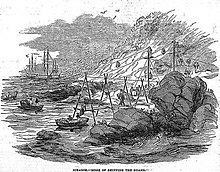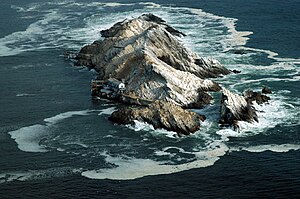Penguin Islands
| Penguin Islands | ||
|---|---|---|
| Halifax Island off the Lüderitz Peninsula | ||
| Waters | Atlantic | |
| Geographical location | 26 ° 30 ′ S , 15 ° 0 ′ E | |
|
|
||
| Number of islands | 15th | |
| Main island | Possession Island | |
| Total land area | 2.35 km² | |
| Residents | uninhabited | |
| Mercury Island off the North Diamond Coast | ||
The Penguin Islands ( German Penguin Island or Penguin Island ), also known as Angra Pequena Islands or Guano Islands known are an island chain of more than 20 small rocky islands and - eilanden , extending over 355 km offshore along the Southern Atlantic Coast of Namibia extends. Hollamsbird , the island furthest from the coast at a distance of 10.3 kilometers, is also the northernmost. The islands lie along the coast of the diamond restricted area between Meob-Chamais (in the Namib Desert) in the north and the Bogenfels in the south. They were also known as guano islands because of their abundance of guano .
geography
The islands together form an area of almost 2.35 km² and a few reach a height of more than 50 meters above sea level. The northernmost island of Hollamsbird has the lowest amounts of guano due to its harsher climate.
The island chain includes twelve islands. The thirteenth entry in a South African document from 1935 is the Little Roastbeef Islets , which mark the southernmost point of the Penguin Islands.
The four largest islands are Possession (90 hectares ), Seal (44), Penguin (36) and Halifax (10). These are also the largest marine islands in Namibia. Only a few inland islands of Namibia have larger areas , such as Impalila at the confluence of the Zambezi and Cuando (2500 hectares or 25 km²). Shark Island (about 40 hectares) in Lüderitz Bay is not counted among the Penguin Islands, probably because it became a peninsula because of an artificial land bridge .
history

The first European to explore the West African coast was Bartolomeu Diaz . Between 1475 and 1478 he set up stone crosses in various places, including on the Diaz peak not far from Lüderitz Bay .
Centuries later, Benjamin Morrell , an American whaler and captain of the Antarctic ship , provided detailed accounts of the coast's wildlife, including whales, lobsters, haddock, seabirds and seals . The islands served as important breeding grounds for birds , seals and penguins (especially African penguins ). He described Ichaboe Island as covered with a 25-foot (8-meter) deep layer of guano. On his return to the United States, he unsuccessfully asked for financial support for his efforts to mine guano.
When the guano deposits in Europe became known in his book History of a Journey to the Southern and Western Coasts of Africa around 1844 , massive exploitation of these deposits began. It has been estimated that around 700,000 to 800,000 tons were mined within a few years on Ichaboe alone. During this time, up to 300 ships called the islands every year. The guano layer was broken up by workers, removed and brought in boats to the ships anchored off the islands. Because of the disputes that sometimes flared up between workers and companies , the British Navy stationed in Cape Town patrolled the islands. In 1861 Ichaboe was declared British territory and in 1867 eleven other islands were annexed by Great Britain (excluding numerous smaller islets and rocky outcrops along the coast). In 1874 sovereign rights over the annexed areas were transferred to the Cape Colony , which kept these islands (and the Walvis Bay enclave ) on the mainland even after the German protected area Deutsch-Südwestafrika was founded . In 1921, Walvis Bay and the islands came completely to South Africa until the area was returned to Namibia on February 28, 1994.
Todays situation
The islands have been under the control of the Namibian Ministry of Fisheries and Marine Economics since 1994. Since the islands are important breeding grounds for the African penguin and other sea birds, the ministry is trying to bring the bird population to a sustainable natural level and only then to approve the economic mining of the guano. For this reason, the islands are controlled by the Namibian Navy and access to the islands is limited. With binoculars, but you can from the Halifax-top look at the penguin colonies on the island of Halifax.
See also
Web links
- Marine Protected Area Namibian Islands (7.31 MB; PDF) of the Namibian Coast Conservation and Management project (NACOMA)
- http://www.shoreline.com.na/islands.htm
Individual evidence
- ↑ PDF at www.nacoma.org.na ( Memento from March 3, 2016 in the Internet Archive )
- ↑ http://www.unep.org/padelia/publications/comp5SouthAfricapt1.pdf



